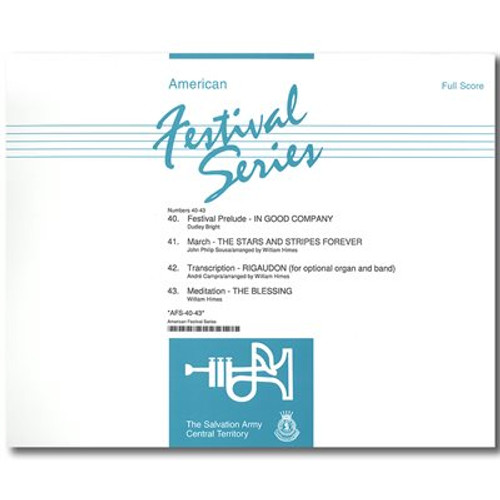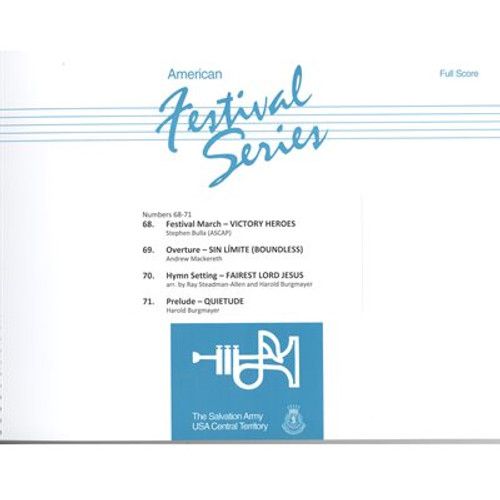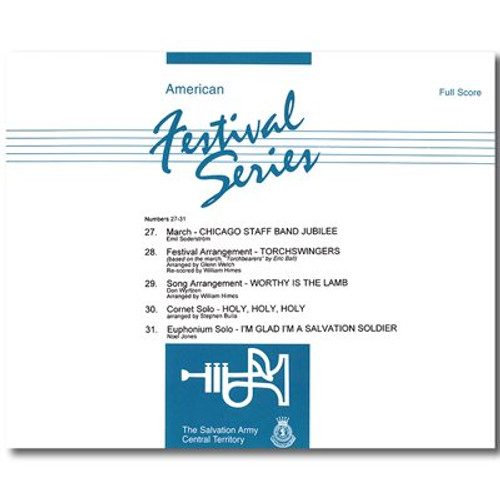Product Description
April 2016 Nos. 51-54
Brian Bowen, editor
Comments by William Himes
Senior Editor, USA Central Territory
Score Sample(view series guide)
51. Song Arrangement- Here at the Cross James Curnow Notes 52. Caprice - And now, Hallelujah! Andrew Mackereth Notes 53. Vienna Philharmonic Fanfare Richard Strauss, arr. William Himes Notes 54. Trumpet (Cornet) Solo - Precious Lord arr. William Broughton Notes
Produced by The Salvation Army - Central TerritorySong Arrangement - Here at the Cross
Program Note:
Commitment and service are the themes of this moving meditation written especially for the Flin Citadel Band in 1971. The opening cornet statement asks "How can I better serve Thee, Lord?" and builds to the refrain's climax "Lord, for Thy service, fit me, I plead." Then, coming as calming reassurance, the work concludes with the chorus "I have pleasure in His service - more than all."Note to the Conductor:
This effective devotional piece first appeared in the 1978 issue of the American Band Journal (USA East) when the composer was asked to rescore his original full band setting to accommodate the reduced instrumentation of this publication. After many years we are pleased to be able to present this music in its original form in the hope it will extend the usefulness of this meaningful setting.
Beginning to bar 39: The music unfolds in a simple, straightforward manner. Strive for a quiet and warm texture.
Bars 40-53: This transition builds to a burst of intensity at bars 45-48. As the music quickly subsides, care must be given to clearly articulate the repeated pitches in the cornet motif in bars 49-51 ("Here at the cross").
Bars 53-68: The flugel solo is accompanied by a mellow trio (horn, baritone, euphonium). Each part must move independently and smoothly under the melody.
Bars 69-84: This music slowly builds in intensity to bar 81. Take care to restrain the crescendo to reach only forte at bar 77, leaving room for the fortissimo peak at bar 81.
Bar 85-end: The music quickly transitions to a contemplative setting of the old chorus, "I have pleasure in his service, more than all, more than all." The music concludes with the opening motif.Caprice - And now, Hallelujah!
Program Note:
Written to commemorate the twenty-fifth anniversary of Norridge (IL) Citadel in 2008, this lively work features General William Booth's song, "O Boundless Salvation," otherwise known as "The Founder's Song." The music expresses praise for a victorious past and hope for an exciting future as stated in the final verse: "And now, hallelujah! the rest of my days shall gladly be spent in promoting his praise."Note to the Conductor:
By definition, a caprice is a fanciful and lively work which does not strictly adhere to any specific form. This exciting and colorful piece certain lives up that expectation. Bands will find the technical challenges to be well worth their effort.
Bars 7-15: Note the metric grouping of the 10/8 time signature: 3+3+2+2. Percussion and horn sections are the foundation of this asymmetrical meter. Note that the last two beats of bar 15 are the exact tempo of the 3/4 meter in the following bar.
Bars 16-42: Even with the bright tempo, this waltz-like section should be light and graceful. At bars 24-30 strive for clarity and balance in the interplay between soprano, solo cornet, 1st and 2nd cornet and 1st and 2nd trombones. The 'O boundless' motif in solo cornets at bars 39-42 transitions back to the 10/8 meter at bar 43.
Bars 43-56: This dance-like section serves as a rhythmic ostinato to theme fragments appearing in flugel, 1st and 2nd cornets and 1st and 2nd baritones. Balance will be achieved with the rhythmic parts playing with a detached style and melody parts playing with a sustained style.
Bars 74-138: Flugel and solo horn introduce this delightful Celtic section with a strong pulse on every downbeat. At bar 98 the euphoniums and basses take up the melody with tom-toms providing helpful support. The melody is tossed from section to section, leading to a percussion break at bar 139.
Bars 139-146: Even with the expanded use of percussion in contemporary brass band repertoire, it is recognized that some bands might not have all of the percussion instruments called for in this eight-bar feature (4 timpani, 3 toms, xylophone). Hence, the option of a cornet feature is provided (in cues) while utilizing the percussion at hand. Another performance option would be to make a cut form 139 to 147.
Bars 147-166: The music transitions to a grandiose statement of the principal theme at bar 155, followed by a brief accelerando back to the festivities at bar 167, ending with a flourish. Be sure to give thorough attention to the final two bars to assure rhythmic precision from top to bottom.Vienna Philharmonic Fanfare
Program Note:
Richard Strauss (1864-1949), preeminent composer of the late romantic era, also had a long career as a conductor. The Fanfare f��r die Wiener Philharmoniker was written in 1924 for the organization's first benefit ball and has been played every year since. Short but stirring, this piece has remained in the Philharmonic's active repertoire for more than 80 years.Note to the Conductor:
Keep in mind this is a work for orchestral brass. Therefore the objective is to attain a sustained and noble sound quality throughout �� regardless of specified dynamics and articulations. Performance will be enhanced if cornet and trombone sections are stood and positioned as a single phalanx either in front of or behind the band.Trumpet (Cornet) Solo - Precious Lord
Program Note:
Thomas A. Dorsey was appointed director of the choir at the Pilgrim Baptist Church in Chicago in 1932. That August, his wife, Nettie, died giving birth to their son, Thomas Andrew, Jr., who perished the very next day. In his grief Dorsey turned to his faith for consolation and out of that tragedy, wrote "Precious Lord, take my hand." Over time this song virtually gave birth to modern gospel music, deeply rooted in faith �� with the strong influence of the blues.Note to the Conductor:
Knowing the story behind this song (see program note) will help the conductor attain a soulful, unhurried interpretation. The accompaniment is quite full through most of the solo. Therefore, conductors may needs to reduce the number of players on each part, depending on the size and strength of the band. Also note the options for band breaks at bars 44-46 and 54-58











